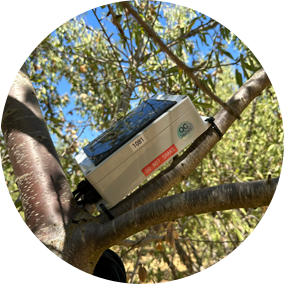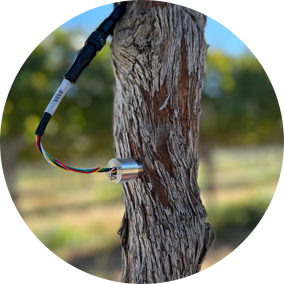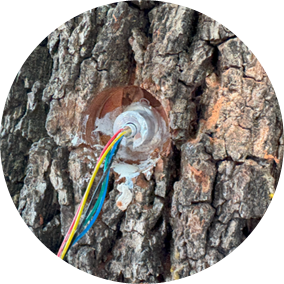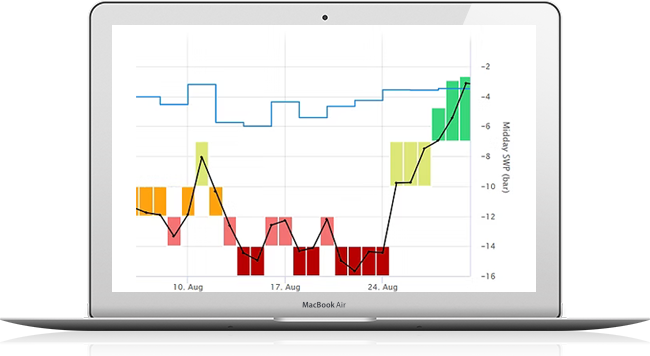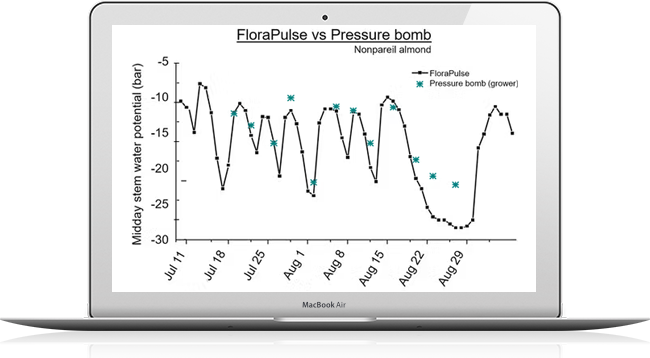About
FloraPulse
Retire the pressure chamber, know exactly when to irrigate, increase crop yield and quality.
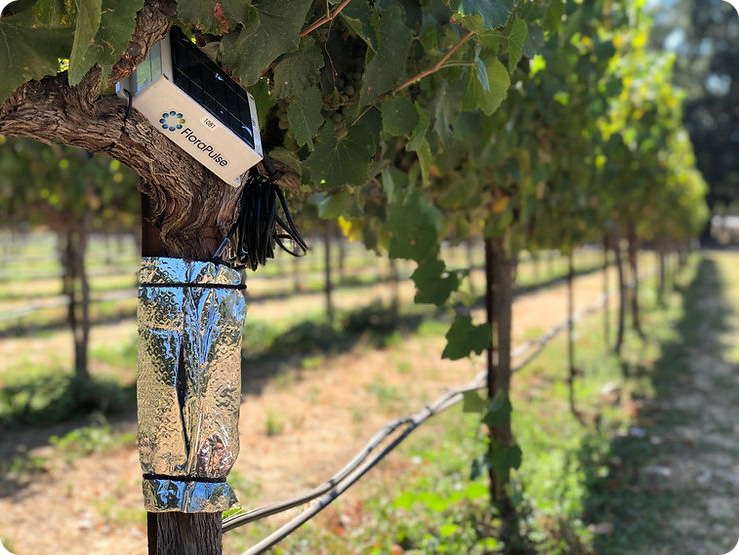
FloraPulse began in the orchards and vineyards of growers.
Since the 1970’s, Alan Lakso, professor of Horticulture at Cornell, had been dragging around the heavy, manual pressure chamber to measure and manage water stress in apple trees and grapevines. Alan was documenting the levels of water stress and their effect on fruit growth and quality. Back then, winegrape growers understood that water stress was important to wine quality, but only had the pressure chamber to measure it.
Why FloraPulse?
Root Rot: An Overview of the Challenge
Root Rot in California poses an ongoing threat to agriculture, impacting a wide variety of crops, especially in areas with poor drainage or heavy rain. This disease is primarily caused by soilborne pathogens like Phytophthora cinnamomi. Understanding and managing root rot is crucial for the health of orchards and vineyards.
As someone who has devoted over 20 years to studying plant diseases in California, I’ve seen firsthand how root rot can devastate crops. It leads to symptoms such as wilting, yellowing leaves, and ultimately, plant death. The economic implications are significant, making effective management strategies a top priority for growers.
Effective Strategies to Prevent Root Rot California
A multifaceted approach is essential for preventing and managing Root Rot California. Here are steps growers can take:
- Ensure proper drainage to prevent wet conditions, which exacerbate the problem.
- Utilize certified disease-free nursery stock to avoid introducing the pathogen.
- Consider planting resistant rootstocks as a long-term solution.
- Implement crop rotation to reduce pathogen buildup in the soil.
- Regularly monitor soil moisture using advanced technology like FloraPulse sensors for accurate irrigation guidance.
By integrating these practices, farmers can significantly reduce the risk of root rot occurring in their valuable crops.
Insights from the Field: Professional Experiences with Root Rot California
During my career, I’ve collaborated with numerous farms across California, leveraging my expertise to tackle root rot challenges. In one case, a vineyard owner in Napa Valley was battling persistent root rot issues. Using FloraPulse technology, we optimized their irrigation practices, which helped manage the disease effectively.
Another memorable case involved an almond orchard in the Central Valley. By introducing resistant rootstocks and improving soil drainage, the orchard saw a remarkable recovery within two seasons. These experiences highlight the importance of tailored strategies in fighting root rot.
What Qualifies as a Root Rot California Emergency?
An immediate root rot emergency in California is identified by rapid plant decline, including wilting and yellowing of leaves, despite adequate irrigation. If left untreated, the disease can lead to substantial crop loss, necessitating urgent intervention.
In such situations, contact your local agricultural extension service for guidance on immediate chemical treatments, such as applying systemic fungicides like Fosetyl-Al. Quick action can prevent the spread of the disease to unaffected plants.
How Technology Revolutionizes Root Rot California Management
The advent of advanced technology has significantly changed how growers manage Root Rot California. FloraPulse, for instance, provides insights into plant water stress levels, aiding in precise irrigation. This minimizes over-irrigation, a common factor in root rot proliferation.
Furthermore, data-driven decisions enhance the efficacy of managing root rot. By utilizing real-time soil moisture data, growers can adjust their practices timely, preventing conditions conducive to the pathogen’s growth.
- Weekly reports on plant water stress trends
- Science-backed irrigation recommendations
- Reliable data for strategic farm management decisions
Technology like FloraPulse not only aids in prevention but also empowers farmers with tools to make informed decisions for long-term crop health.
Addressing Common Concerns about Root Rot California
Many growers worry about the cost and complexity of implementing new technologies and resistant rootstocks. However, the investment often pays off through increased plant resilience and yield. By reducing dependency on chemical fungicides, these strategies offer a sustainable solution.
Another concern is the time required to see results from preventive measures. While cultural practices and resistant rootstocks may take a season or two to show full benefits, the long-term advantages cannot be overstated. Patience and persistence play key roles in overcoming root rot challenges.
In my experience, addressing these concerns with effective communication and demonstrating success stories can alleviate hesitation and encourage the adoption of advanced management techniques.
What is Root Rot California, and why is it a significant issue for growers?
Root Rot California is a disease primarily caused by soilborne pathogens, such as Phytophthora cinnamomi, which thrive in poorly drained soils and cause severe damage to crops by attacking their roots. In California, this problem is especially pertinent due to the region’s diverse agricultural landscape that includes many high-value orchards and vineyards. As someone who’s spent over 20 years studying plant diseases in this area, I’ve seen firsthand the devastating effects it can have on crop yields and the local economy. It’s crucial for growers to be proactive in their management practices to mitigate these impacts.
What are some misconceptions about managing Root Rot California?
A common misconception is that once plants are infected, there’s little that can be done. While prevention is indeed more effective, there are strategies to manage and even reduce the spread of root rot. One effective practice is improving soil drainage to reduce the pathogen’s ideal conditions. Also, the belief that high levels of chemical fungicides are always the solution is misguided. By using technology like FloraPulse sensors for precise irrigation, as well as planting resistant rootstocks, growers can manage root rot sustainably. Understanding and applying these measures can significantly reduce dependency on chemicals.
Can technology really help in managing Root Rot California, and how?
Absolutely, technology is a game-changer in this field. At FloraPulse, we’ve seen how precise irrigation management can influence the health of crops. Our sensors provide real-time data on plant water stress, allowing farmers to make informed decisions about their irrigation practices. For example, a vineyard owner we worked with in Napa Valley was able to significantly manage root rot issues by optimizing their irrigation with our technology. Utilizing such data-driven insights reduces over-irrigation, which is often a contributing factor to root rot. How would you envision using such technology in your agricultural practices?
How can growers integrate preventive strategies for Root Rot California effectively?
Integrating preventive strategies involves a comprehensive approach. First, ensure proper drainage in fields to prevent waterlogging–the pathogen’s favorite environment. Using certified disease-free nursery stocks and practicing crop rotation are also key strategies. Additionally, consider disease-resistant rootstocks to bolster plant defenses. This may take a season or two to fully realize benefits, but patience will pay off in resilience and yield. FloraPulse technology aids this by providing irrigation guidance that complements these strategies perfectly. What other factors do you think could support these practices effectively?
What are the signs of a Root Rot California emergency, and how should it be handled?
A Root Rot California emergency is marked by a sudden decline in plant health, such as wilting and yellowing leaves, despite regular irrigation. These are warning signs that need immediate attention. In such cases, seeking guidance from local agricultural services for systemic fungicide applications, like Fosetyl-Al, can help control the spread. Quick, informed action is vital to prevent crop loss. It might be interesting to consider how often you monitor similar signs in your crops and the protocols you have in place for emergencies.
What role do resistant rootstocks play in combating Root Rot California, and are they worth the investment?
Resistant rootstocks act as a first line of defense against root rot, limiting the pathogen’s ability to cause damage. Although initially costly, they provide long-term benefits by enhancing plant resilience and reducing future management costs and losses. In an almond orchard in the Central Valley, the introduction of such rootstocks led to a remarkable recovery from root rot. While the investment might seem significant, the payoff in healthier, more robust crops makes it a worthwhile strategy for many growers. Considering the long-term health of your crops, do you see resistant rootstocks fitting into your management plan?
What are some common concerns about adopting new technologies or resistant rootstocks to combat Root Rot California?
Common concerns include the upfront cost and complexity of implementing new technologies or resistant rootstocks. However, these investments often translate to increased yield and reduced chemical dependence in the long run. From my experience, growers who have embraced these changes tend to see measurable improvements in crop health and sustainability. While the initial learning curve can be steep, the benefits often outweigh the challenges. How might you weigh these considerations when planning future investments in your agriculture enterprise?
How can FloraPulse technology specifically assist in managing Root Rot California?
FloraPulse technology assists by providing precise, real-time data on plant water stress, enabling growers to make informed irrigation decisions–an essential factor in preventing root rot. By minimizing over-irrigation, which often contributes to the development of root rot, FloraPulse helps maintain optimal soil conditions. We’ve seen significant success in vineyards and orchards where our technology led to more consistent and healthier crop yields. With our tools offering science-backed insights, growers can tailor their irrigation practices to the unique needs of their crops. How do you currently approach data-driven irrigation in your operations?
How It Works
How It Works
The FloraPulse system is a microchip tensiometer (microtensiometer) that is embedded into the tree woody tissue and directly measures the water status, known as water potential. Because the measurement is taken directly inside the water-carrying tissue, readings are very accurate and reliable. You receive daily midday stem water potential readings, along with science-backed irrigation recommendations.
Weekly Reports
Receive weekly reports on your crop’s water-stress history, color-coded by stress level. Use clear, detailed data to adjust your irrigation and get that perfect vintage, that perfect yield. Every year.
Scientific Validation
The sensor data has been validated against the Scholander chamber with good correlation in prune, almond, winegrape (and others).
Technology Backers

Our technology has been funded by the NSF and USDA, and was originally developed at Cornell University.
What is FloraPulse?
The most accurate way to irrigate.
Customer Testimonials
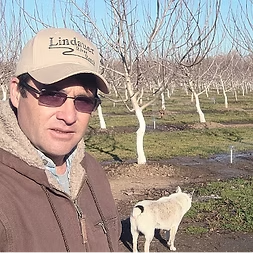

“We were extremely happy with the FloraPulse system we tested in our prune orchard this year. We found that the FloraPulse readings correlated very well with our pressure bomb readings…
Michael Vasey
Lindauer River Ranch
Red Bluff, California
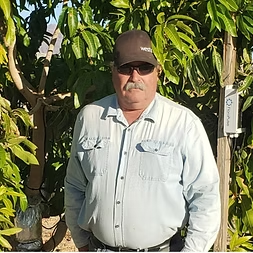

“I am very happy with the FloraPulse unit. I grow a rare mango crop, in a desert environment with extremely high summer temperatures, in alluvium soil that has very limited…
Rod Chamberlain
Wong Farms
Mecca, California


